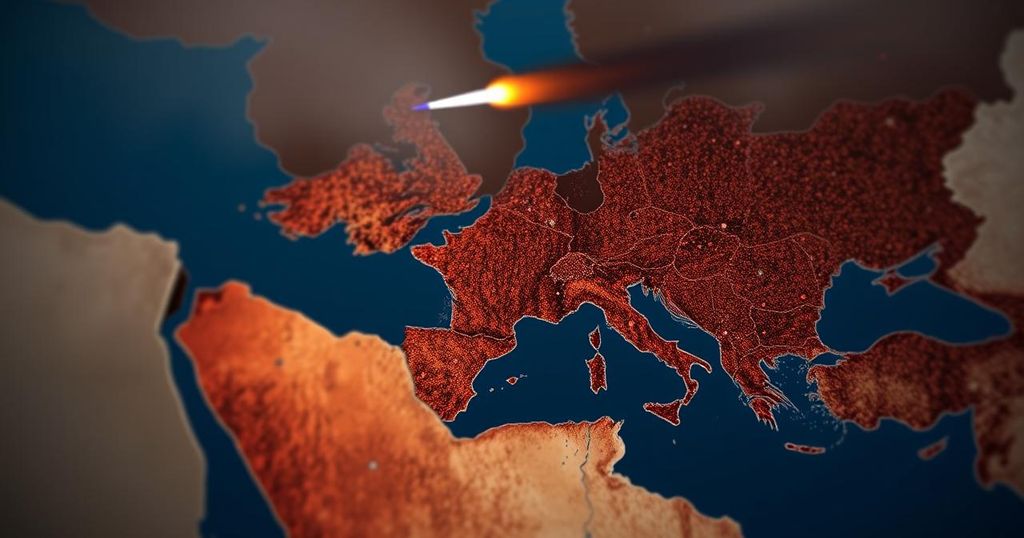In recent weeks, Iranian-affiliated militias in Iraq have ramped up their offensive against Israel, conducting around 40 missile and drone attacks as a response to intensified military actions within the region. Following the death of Hezbollah leader Hassan Nasrallah, Iran has turned to its less capable proxies to challenge Israel, reflecting a strategic shift amid the ongoing conflict. Analysts highlight the growing collaboration among these factions, even as Israel intensifies its airstrikes against Iranian-linked targets within Syria.
Iran-aligned militia groups in Iraq have intensified their assaults on Israel, executing approximately 40 missile, drone, and rocket strikes within the recent two-and-a-half weeks. This escalation marks a notable increase in a largely covert proxy conflict that has spread across the Middle East since the onset of the Gaza war in October last year. The Washington Institute, a prominent US think tank, indicates that these attacks surged following a significant Israeli airstrike that eliminated Hezbollah leader Hassan Nasrallah on 27 September. Given that Hezbollah has been significantly impacted by the ongoing Israeli military campaigns in Lebanon, and Hamas has been degraded through prolonged conflict in Gaza, Tehran is increasingly leveraging less advanced factions within its expansive network of regional proxies to target Israel. Military analyst Michael Knights from the Washington Institute notes, “The number of missiles and drones being fired from Iraq [at Israel] has gone through the roof. They’ve moved into a higher gear to demonstrate their support for Hezbollah.” This development reflects Iran’s strategy of bolstering its “axis of resistance” while also manifesting the competitive dynamics among these factions. The Iraqi militias, although less formidable than Hezbollah, appear eager to assert their relevance against their counterparts. The strategic missile launches from Iraq underscore Tehran’s utilization of interconnected militia networks in Syria, Iraq, and Yemen, especially amidst potential Israeli retaliation after Iran’s launch of 180 ballistic missiles aimed at Israel on 1 October. Israel’s military response has included numerous airstrikes and significant ground interventions in Syria, all aimed at mitigating threats posed by Iranian proxies while safeguarding vital supply lines that facilitate material support to Hezbollah. Accidental explosions of Hezbollah pagers have provided unexpected insights into these militant networks, as noted by Kirsten Fontenrose of the Atlantic Council, describing the incident as a “momentary flash of light on a dark network map.” In recent operations, Israeli special forces executed a raid against an Iranian-associated armament site in western Syria, targeting essential infrastructure critical for Iran’s operations. Despite the aggressive nature of these hostilities, Israel has yet to conduct direct strikes within Iraq, though it continues targeting Iraqi militants in Syria who are linked to an alliance of Iran-backed factions known as the Islamic Resistance of Iraq (IRI). This coalition has claimed responsibility for various strikes against Israel and US forces and has cooperated increasingly with the Houthi militia, suggesting an alignment that could threaten regional stability further. Israel’s military actions extend to Yemen, where it has conducted targeted strikes against installations, reflecting a broader strategy of intimidation towards Iran. However, this theatre of conflict has largely been neglected by both media and policymakers, as remarked by Michael Knights, who asserts, “Every big war has its forgotten corners.”
The article discusses the rising hostilities from Iranian-linked militias based in Iraq against Israel, amid a backdrop of heightened tensions following the Gaza war and a series of military escalations. This situation builds upon decades of proxy conflicts in the region, primarily involving Iran-sponsored groups such as Hezbollah and Hamas, with Iraq’s militias stepping into a more prominent role due to the weakening of these larger entities. Recent events, such as airstrikes and retaliatory measures, highlight the complex mesh of geopolitical strategies and conflicts that characterize the Middle East, with various factions vying for influence and demonstrating solidarity amid growing threats.
In conclusion, the escalation of missile and drone attacks by Iran-linked militias from Iraq against Israel signifies a new phase in the ongoing proxy conflict in the region. With the diminished capabilities of major actors like Hezbollah and Hamas, Iran has redirected its focus toward its junior proxies, who now appear increasingly emboldened. The interplay of military operations, retaliations, and intelligence activities underscores the intricate dynamics shaping this conflict, suggesting an evolving landscape where various factions vie for prominence and resources. As noted, the underreported aspects of this conflict merit greater attention from stakeholders and analysts alike.
Original Source: www.theguardian.com






